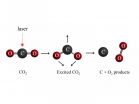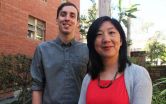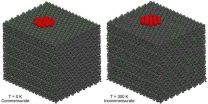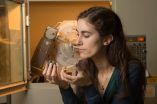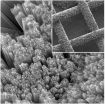(Press-News.org) Many of those who are genetically predisposed to develop atrial fibrillation, which dramatically raises the risk of stroke, can be identified with a blood test. This is shown by new research from Lund University in Sweden.
The number of people affected by atrial fibrillation is rising rapidly, partly as a result of the ageing population.
Over recent years, a research group at Lund University in Sweden, working with other universities and hospitals in Europe and the USA, has identified twelve genetic variants in the human genome that increase the risk of atrial fibrillation. The research group has now studied the possible clinical benefits of a DNA test:
"One in five people have a genetic weakness that means they have twice as high a risk of developing atrial fibrillation as those with a low genetic risk. This genetic risk is therefore one of the strongest risk factors for atrial fibrillation that we know of in people without overt cardiac disease. It increases the risk as much as high blood pressure, for example", said Olle Melander, Professor of Internal Medicine, and Gustav Smith, Associate Professor in Cardiology, both from Lund University.
Since the symptoms of atrial flutter can be weak and unclear, they are sometimes difficult to pick up. However, even those with weak or absent symptoms of atrial flutter are at significantly higher risk of stroke.
"In patients who are suspected of having temporary but recurrent episodes of atrial fibrillation, or in people with high blood pressure, it can be important for doctors to look at their genetic predisposition using a blood test. The test can give guidance as to how often and how intensively doctors need to screen for presence of atrial fibrillation in these individuals. We also consider that more widespread treatment of high blood pressure may be justified in those with a high genetic risk of atrial fibrillation", explained Professor Melander.
Patients already diagnosed with atrial fibrillation were also studied, and the researchers observed that if they had the risk genes, their risk of stroke was increased by a further 70–80 per cent.
If an individual with atrial fibrillation is regarded as having a sufficiently high stroke risk, lifelong treatment with anticoagulant drugs such as warfarin is required in order to lower the risk.
"There are also benefits of checking the genetic risk of those who have already been diagnosed with atrial fibrillation. The test makes it easier to correctly assess whether anticoagulant medication is necessary to prevent stroke, especially for those under 65", said Olle Melander.
The research data was taken from a long-term follow-up of 27 400 participants in a population study.
"The present results are one of several examples of how genetics research is not only an effective way of identifying new disease mechanisms, but can also have clinical applications and help doctors and patients to decide on the right tests and treatment", said Olle Melander.
The research was funded by, among others, the Swedish Heart-Lung Foundation, the Swedish Research Council and the EU. The findings were published recently in the American journal Stroke.
INFORMATION:
About atrial fibrillation and stroke:
In atrial fibrillation, the normal regulation of the heart's rhythm gets out of control, and this has a detrimental impact on the heart's ability to pump blood round the body. Symptoms can vary from breathing difficulties and heart failure, which require emergency medical care, to symptoms that are more diffuse and difficult to identify, for instance occasional heart palpitations that last only a short time. High blood pressure raises the risk of atrial fibrillation and is estimated to be behind one third of cases. There are certain treatments that can be used to relieve or cure atrial fibrillation.
The most serious consequence of atrial fibrillation is a dramatic increase in the risk of stroke, as blood clots can form in the atrium of the heart which are then transported to the brain, causing major damage. Every year, around 30 000 people in Sweden suffer a stroke, of whom half either die or are left severely disabled.
(Sources: Lund University and Swedish Heart-Lung Foundation)
Johnny Depp has an unforgettable face. Tony Angelotti, his stunt double in "Pirates of the Caribbean," does not. So why is it that when they're swashbuckling on screen, audiences worldwide see them both as the same person? Scientists from the University of California, Berkeley, have cracked that mystery.
Researchers have pinpointed the brain mechanism by which we latch on to a particular face even when it changes. While it may seem as though our brain is tricking us into morphing, say, an actor with his stunt double, this "perceptual pull" is actually a survival mechanism, ...
yphoon Phanfone's eye appeared the size of a pinhole on visible imagery from NASA's Aqua satellite on Oct.3.
The MODIS instrument or Moderate Resolution Imaging Spectroradiometer that flies aboard NASA's Aqua satellite captured a visible image of Phanfone moving through the Northwestern Pacific Ocean on Oct. 3 at 4:20 UTC (12:20 a.m. EDT). The tiny open eye of the storm was surrounded by a thick band of thunderstorms. The MODIS image also showed a very thick and large band of thunderstorms south of the center and spiraling into the eye.
On Thursday, Oct. 2, Typhoon ...
VIDEO:
Mexico's western coast is again dealing with rain, wind and rough surf from another tropical storm. NOAA's GOES-West satellite saw the formation of Tropical Storm Simon on Oct. 2. A...
Click here for more information.
Mexico's western coast is again dealing with rain, wind and rough surf from another tropical storm. NOAA's GOES-West satellite saw the formation of Tropical Storm Simon on Oct. 2. A NASA animation of NOAA's GOES-West satellite imagery shows the development ...
About one-fifth of the Earth's atmosphere is oxygen, pumped out by green plants as a result of photosynthesis and used by most living things on the planet to keep our metabolisms running. But before the first photosynthesizing organisms appeared about 2.4 billion years ago, the atmosphere likely contained mostly carbon dioxide, as is the case today on Mars and Venus.
Over the past 40 years, researchers have thought that there must have been a small amount of oxygen in the early atmosphere. Where did this abiotic ("non-life") oxygen come from? Oxygen reacts quite aggressively ...
Curiosity helps us learn about a topic, and being in a curious state also helps the brain memorize unrelated information, according to researchers at the UC Davis Center for Neuroscience. Work published Oct. 2 in the journal Neuron provides insight into how piquing our curiosity changes our brains, and could help scientists find ways to enhance overall learning and memory in both healthy individuals and those with neurological conditions.
"Our findings potentially have far-reaching implications for the public because they reveal insights into how a form of intrinsic motivation ...
White Americans may view diversity and multiculturalism more negatively as the U.S. moves toward becoming a minority-majority nation, UCLA psychologists report.
As part of their study, the researchers divided 98 white Americans from all regions of the country — half male, half female, with an average age of 37 — randomly into two groups. One group was told that whites will no longer be the majority in the U.S. by 2050; in fact, this is likely to be true as soon as 2043, according to some projections. The second group was told that whites would retain their majority status ...
BELLINGHAM, Washington, USA -- New applications of structures and materials that replicate complex yet efficient arrangements that have evolved in nature over millennia are featured in a special section on biomimetic and bioinspired materials for applications in biophotonics in the October issue of the Journal of Biomedical Optics. The journal is published by SPIE, the international society for optics and photonics, in the SPIE Digital Library. Several of the peer-reviewed articles are accessible via open access.
"Biomimetic and bioinspired materials present an emerging ...
VIDEO:
The video compares the two sliding states of the C60 flake attached to the tip of the microscope: a) commensurate state at low temperature where the C60 do not rotate...
Click here for more information.
About 3500 years ago, man invented the wheel to make life easier. Then, thanks to Leonardo Da Vinci's genius, the wheel was made smaller to obtain ball bearings. And today? "Today we are trying to get even smaller: scientists are thinking about nano-bearings", comments ...
PULLMAN, Wash.—A Washington State University undergraduate has helped develop a new method for detecting water on Mars. Her findings appear in Nature Communications, one of the most influential general science journals.
Kellie Wall, 21, of Port Orchard, Wash., looked for evidence that water influenced crystal formation in basalt, the dark volcanic rock that covers most of eastern Washington and Oregon. She then compared this with volcanic rock observations made by the rover Curiosity on Mars' Gale Crater.
"This is really cool because it could potentially be useful for ...
COLUMBUS, Ohio—Is it a solar cell? Or a rechargeable battery?
Actually, the patent-pending device invented at The Ohio State University is both: the world's first solar battery.
In the October 3, 2014 issue of the journal Nature Communications, the researchers report that they've succeeded in combining a battery and a solar cell into one hybrid device.
Key to the innovation is a mesh solar panel, which allows air to enter the battery, and a special process for transferring electrons between the solar panel and the battery electrode. Inside the device, light and oxygen ...


